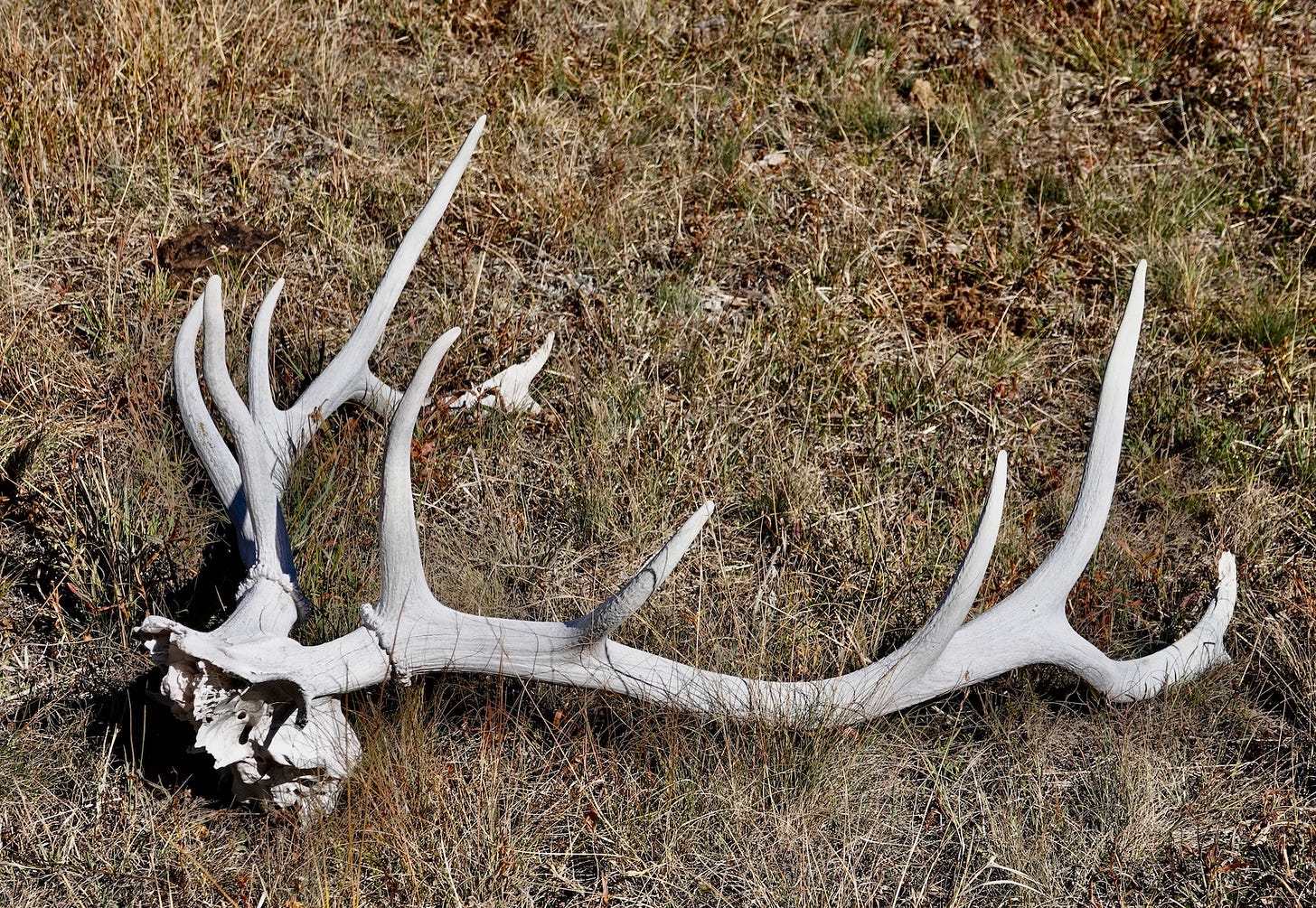At this time of year, Yellowstone (and our Gardiner neighborhood) resounds with the energetic bugling of elk, a sound as enchanting and distinctive as the howling of wolves. When I photographed this male mid-bugle, he was near a group of his chosen females, often called a harem. He bugled to inform those females, any male competitors, and possibly me, that he was present and powerful and primed to defend his harem during the annual breeding ritual, the rut.
This male looked healthy and big: standing five feet tall at the shoulder, sporting large, thick antlers, and weighing maybe seven hundred pounds. Though I wasn’t close enough to smell him, he may have emanated a scent created by urinating on his body to make him more attractive to females. Since the biggest males with the biggest antlers usually win the right to breed, he had a good chance of mating with the females he attracts.
This bugler is one of up to twenty-thousand elk that graze Yellowstone’s high grasslands in six or seven summer herds. By early September, females, yearlings, and calves congregate for the rut in large groups. Males, driven by the breeding instinct, arrive one by one to collect females. An average harem has sixteen females, and the male will breed with as many of them as possible. Accomplishing this requires high energy and constant vigilance; the interval when a female is ready to breed lasts less than twenty-four hours.
Competitors will surely try to usurp this male’s harem. Once he spies a contender, he will bugle to tell the intruder to move on. If that doesn’t deter the challenger, the two males may walk, as rutting bison do, side by side, assessing each other’s antlers, energy, and readiness to roughhouse. If the competitor persists, the two will lock antlers and wrestle with them. Though loud and strenuous, these battles rarely cause serious injury. Eventually the loser gives up and walks or runs away. The winner takes a breath, checks his harem, and scans for the next competitor.
Researchers have found that the more competitors in an area, the smaller the average harem. Somehow, male elk understand that fighting to maintain too large of a harem wastes precious energy that is better spent on essential reproduction.
But however large the harem, maintaining and servicing take a toll. While his females grazed, building up the fat their bodies will need to nourish a developing fetus through a harsh winter, this male rarely ate. Instead, he looked around, herded his harem, bugled, and challenged competitors. While depleting and not replenishing energy, he could lose twenty percent of his body weight by the time the rut ends in mid-October.
When the rut ends, so will the battles with competitors. Tired, this male will depart with a few other males—even ones he wrestled with—in a small bachelor herd. They seek security in numbers from predators.
But as fall fades, if he hasn’t eaten enough to replace lost fat, weight, and strength, he may succumb to the trials of winter or the attacks of wolves. His passing will present a large body that will feed predators and scavengers and insects and slowly enrich the soil. He will leave his antlers behind to bleach over the years and remind us that death feeds life in Yellowstone’s wild lands.
Though he may perish, he will have done his job, using his experience, strength, and energy during the rut to help assure the survival of Yellowstone’s elk herd.
Thanks for joining me in this Love the Wild! If you haven’t yet subscribed, I hope you’ll do so. It’s free and brings a Love the Wild letter to your inbox each week. In addition to stories inspired by photos, you’ll enjoy a variety of podcasts, photo essays, opinion pieces, excerpts from my books, and more. With each, I hope to warm your heart and excite your mind as we share moments with wildlife and in wild lands.
I write, speak, and photograph to protect wildlife and preserve wild lands. My bestselling In the Temple of Wolves; its sequel, Deep into Yellowstone; and its prequel, The Wilds of Aging are available signed. My books are also available on Amazon unsigned or as eBook or audiobook.
All photos by Rick Lamplugh






I haven’t been to Yellowstone in a few years, it’s so beautiful there. I currently live in Quebec, we have wolves up here,so I still see them!!!
Great blog and beautiful photos of a magnificent bull. We had one of our best rut-watching experiences ever in Moraine Park at RMNP a couple of days ago — more than a dozen bulls vying for the ladies’ attentions. Headed to YNP in four days — looking forward to seeing wolves, big bull elk, bison (as always) and moose. Hoping to see a grizzly or two on this trip, too. Enjoy all your books and now your blog, Rick!